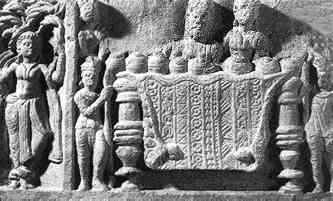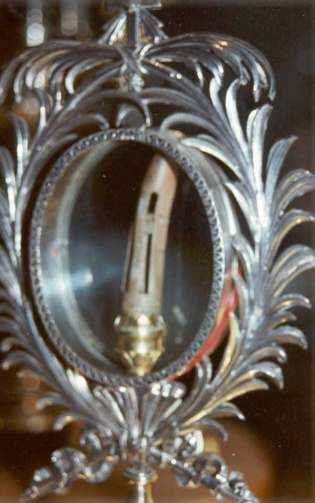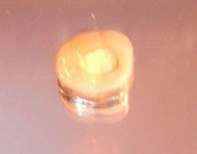|
Relics If cleanliness is next to godliness, then saintliness is next to cleanliness, and it only stands to reason that rottingliness is next to saintliness.
If cleanliness is next to godliness, then saintliness is next to cleanliness, and it only stands to reason that rottingliness is next to saintliness. So the theory goes like this: Since you're pretty far from saintliness, a good way to climb the ladder is to wear the big toe of a saint in a pendant around your neck. The Egyptians invented the concept of mass producing of relics. The pyramids are essentially gigantic reliquaries, and Mummies are the prize at the bottom of the Crackerjack box (but there ain't no Coup de Ville hidin' there). A mummy is a great way to commemorate a loved one or a living god, by saving most of the good bits (but none of the brains or squishy parts). Later, the Greeks and Romans would come up with various creative funtime activities involving the corpses of beloved figures. Various bits and pieces of the Buddha have been so venerated that they have actually sparked wars, which would have the Buddha spinning in his grave, if he were in fact in his grave, which he obviously is not. The Catholic church has a wide range of practices and beliefs about the vast importance of relics, which is detailed in its teachings and official documents, with the words "but we're not worshiping them" appearing every third sentence or so.
While these ideas might seem obvious, the formal announcement came way too late to do any good. The earliest example of Christian relic "veneration" (not worship, we swear!) dates back to the 2nd century, and by the 4th century, things were heating up. Somewhere around 320 A.D., the mother of all relics was discovered by Helena, mother of the Roman Emperor Constantine, who had sold his soul to Jesus Christ in exchange for ruling the world. Legend says Helena was divinely inspired to travel to Jerusalem, where she found the True Cross, the hunk of wood on which Jesus was crucified. The discovery wasn't just a bonanza of pious devotion it became an economic powerhouse too! In no time at all, little splinters of wood were being sold all over Europe as "fragments of the True Cross." Commerce rules! Needless to say, every single one of these samples was exhaustively carbon-dated and verified, so if you happen to have a splinter of wood that is billed as a piece of the True Cross, you should rest assured that it's genuine. With the exception of the multitude of splinters, the True Cross was "venerated" (not worshiped!) for several centuries until the famous Muslim warrior Saladin captured Jerusalem near the end of the 12th century. Christian propaganda states that he tied it to his horse's tail and rode around the city dragging it behind him. Much like modern day claims that Saddam Hussein was seeking Weapons of Mass Destruction, this bit of incendiary nonsense was used to justify a massive war effort (in this case, the third Crusade), despite never being proven. No one ever saw the cross again. Other big time bonanza relics fared better, either in rumor or fact. The Apostle Thomas was particularly well preserved, with his head being kept in Italy, and other pieces of him scattered across the globe, as far as India, where a hodge-podge of bits can be found.
The heads of Sts. Peter and Paul are allegedly sitting in St. John Lateran church in Rome. The Knights Templar were rumored to have some of the biggest and baddest relics in history, including the Holy Grail (the cup used at the last supper which was inexplicably also used to catch Christ's blood from the cross) and the head of the John the Baptist. (Whoo-hoo! Relics don't get much better than that!) While it's rather entertaining to imagine the Knights in secret ceremonies gathered around the severed head, there is a more likely explanation of their big secret. A body of circumstantial evidence suggests that the Knights were actually in possession of the Shroud of Turin for several centuries, before being exterminated by the Inquisition. The Shroud was thought to be the burial cloth of Jesus after his crucifixion and it bears a nearly inexplicable image of a crucified man. The claim is pretty controversial, and carbon dating sponsored by (and secretively controlled by) the Catholic church allegedly proved the cloth only dates back to the Middle Ages, but there's enough wiggle room in the details of all this for those who want to believe. The main body of relics tend to be bits and pieces of saint's bodies, such as toes, fingernail clippings, hair, blood-stained whatevers, teeth and bones. Interestingly, no one ever claims to have saved the brains of a saint, to the distress of zombies everywhere. A little-known fact: The altar piece in every Catholic church has at least one and usually several relics imbedded inside it. Yes, that's right, there's dead saint parts in the altar! And people eat off that thing! At the point that the aforementioned Council of Trent issued guidelines urging everyone to calm down about the whole relic thing, the craze had really reached its peak. Just a few years earlier, around 1500, a showing of the body of St. Francis Xavier ended when a particularly devout person bit off one of the holy one's toes. It's not clear whether this was for purposes of keeping the toe as a relic or simple Cannibalism (OK, maybe not so simple). Xavier's right arm was seized at another showing. Despite all this abuse, the body allegedly showed signs of "incorruptibility," a theological term for an especially sanctified miracle which literally means "he don't stink so bad." In 1975, the Catholic church officially refused to comment on whether Xavier still didn't stink so bad, but it did indicate they knew where the bones were (except for the big toe and right arm).
On eBay and in shady backroom street dealings, relics of Elvis Presley are a hot commodity. The most common (and least expensive) of these are sweat-soaked items of clothing, which Elvis considerately threw into the crowds at most of his concerts. But that's not enough for some people. One woman boasts of owning some of the king's toenail clippings and a "wart" (don't ask me how she got that). And a recent auction tried to attract a minimum bid of $100,000 for one of the King's teeth and some hair. The tooth was allegedly saved by a dentist who worked on Presley, which surely has to be some kind of violation of the Hippocratic oath. One anonymous European bidder claimed to be a Cloning company that was looking to brew up a crop of fresh young Elvises for future posterity.
|
 As of 1545, the official line has been that the bodies of saints should be "venerated by the faithful, for through these (corpses) many benefits are bestowed by God on men." The council also recommended condmemning anyone who says otherwise. At the same time, the Church also ordered that all relic-related "superstition shall be removed and all filthy lucre abolished" and that "the visitation of relics must not be by any perverted into revellings and drunkenness."
As of 1545, the official line has been that the bodies of saints should be "venerated by the faithful, for through these (corpses) many benefits are bestowed by God on men." The council also recommended condmemning anyone who says otherwise. At the same time, the Church also ordered that all relic-related "superstition shall be removed and all filthy lucre abolished" and that "the visitation of relics must not be by any perverted into revellings and drunkenness." One of the most impressive Thomas relics is found at the Church of the Holy Cross in Jerusalem, the finger which doubting Thomas presumably stuck in Jesus' nail holes. The finger is encased in a glorious silver mounting (to be venerated, but definitely not worshipped). The ever-industrious Helena was the alleged finder of the finger, as well as other items featured at the church, such as thorns from the Crown of thorns and one of the nails used in the crucifixion.
One of the most impressive Thomas relics is found at the Church of the Holy Cross in Jerusalem, the finger which doubting Thomas presumably stuck in Jesus' nail holes. The finger is encased in a glorious silver mounting (to be venerated, but definitely not worshipped). The ever-industrious Helena was the alleged finder of the finger, as well as other items featured at the church, such as thorns from the Crown of thorns and one of the nails used in the crucifixion. In these godless times, of course, the "veneration" (not worship!) of relics is decidedly unfashionable, at least as far as religious figures go. But there is one person whose sanctity is of such towering greatness that relics are incredibly valuable, to the point of sparking hysterics. No, not
In these godless times, of course, the "veneration" (not worship!) of relics is decidedly unfashionable, at least as far as religious figures go. But there is one person whose sanctity is of such towering greatness that relics are incredibly valuable, to the point of sparking hysterics. No, not